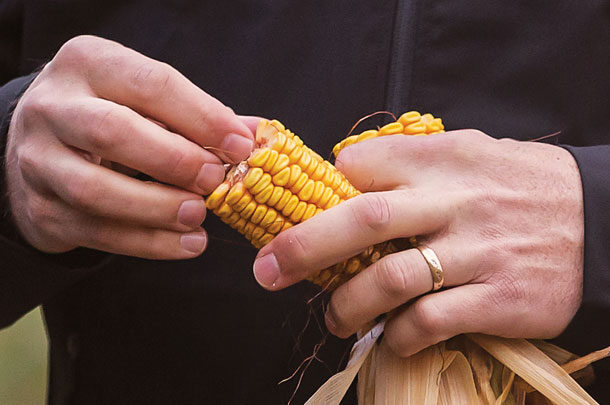Getting the corn harvested at that precise moment can be difficult, but there are ways to maximize your chances of hitting that moment and getting the most out of your acres.
Each year varies and every acre has different needs; variable factors such as weather and pest pressure can drastically impact drydown. The best thing to do as the crop is maturing is to keep walking those fields to observe and record its progress so you’re well informed to make detailed harvest plans. The corn plant will approach silage harvest maturity around 35 to 45 days, or about 900 growing degree units (GDUs) after silking – so taking note of the silking date is a vital first step in harvest timing determinations.
Keep careful track of conditions to determine when you’ve reached the perfect drydown point for harvest. Drought-stricken corn silage with small ears, or none at all, will dry very slowly, so you can delay harvest in those fields. Well-eared corn silage will dry more quickly, since the ear will be consuming a lot of the plant’s moisture. Those fields should be some of the first to be harvested when the moisture level is right.
Corn silage maturity at harvest has a dramatic impact on its nutritional value. The improvement in feed quality as harvest approaches is largely the result of the plant’s increasing starch content as it matures. However, having a dry matter (DM) content that’s too high will reduce the fiber digestibility of the corn silage. Although fiber digestibility does drop at a slower rate than the starch increase, you should manage harvest moisture carefully as well (see Figure 1). The plants with superior late-season plant health will help deposit starch and slow the decline of fiber digestibility.

Harvesting corn silage before plants reach optimal moisture levels reduces yield per acre and starch deposition, resulting in hidden economic loss. Harvesting corn silage with moisture levels at more than 70 percent will not only reduce yield, but also may result in seepage and an undesirable fermentation.
Research suggests that unprocessed silage achieves its maximum net energy yield at 34 percent DM, or 66 percent moisture. Silage processed with a kernel processor achieves a maximum net energy yield of 37 percent DM, or 63 percent moisture, if properly processed. Sampling is the best way to monitor plant maturity and harvest timing.
A quick way to determine if you’re getting close to an optimal silage harvest is to break a cob in half and look at the kernels. After denting, you can see a whitish line on the kernels, which is where the solid and liquid parts of the kernels are separated while the plant matures and dries. This line progresses from the outer edge of the kernel toward the cob. When the milkline reaches the cob, a black layer will be visible. Silage harvest typically begins when the milkline is visible at the kernels’ halfway point.
This method is only a reference, though. It’s more important to harvest a representative sample from the field to conduct a moisture test. The plants will have to be processed in a chipper or shredder, and then the DM can be determined using one of several methods. A sample can be sent into a lab for the DM determination, or checked in a drying oven or using a food dehydrator. Even an old microwave can help make a DM determination.
Your exact DM content goal will also be impacted by your storage structures, since each has a different target. Most silage bunkers and drive-over piles target 32 to 38 percent DM, while a silage bag may perform best with 35 to 40 percent DM. Upright silos also have specific targets that vary by structure type. Make sure you harvest your corn silage at the correct moisture range for the storage structure you intend to use and adjust to meet your feeding needs.
Another factor that needs to be considered is the time required to harvest. Since the corn plant will average about 1 percentage point of moisture lost each day during the optimum harvest moisture range, adjust the start date of your harvest to maximize the time in the correct range. You should also stage fields so you have a continuous supply of silage at the proper moisture content for your storage structure. This is a big challenge, since we can’t account for breakdowns and weather – but having a good plan in place will help.
Factoring in your scouting information and asking lots of questions will help you make important adjustments to your overall harvest management plan that reflect what’s happening in each field. With careful planning and good data, you can put the drydown period to work for you. FG

-
Matt Laubach
- Dairy Specialist
- DuPont Pioneer
PHOTO: By breaking a cob in half, you can see the milkline. A half milkline indicates correct maturity has likely been reached for ensiling; however, there are more accurate means to test moisture levels, including microwave methods, lab analysis, etc. Photo provided by Matt Laubach.













